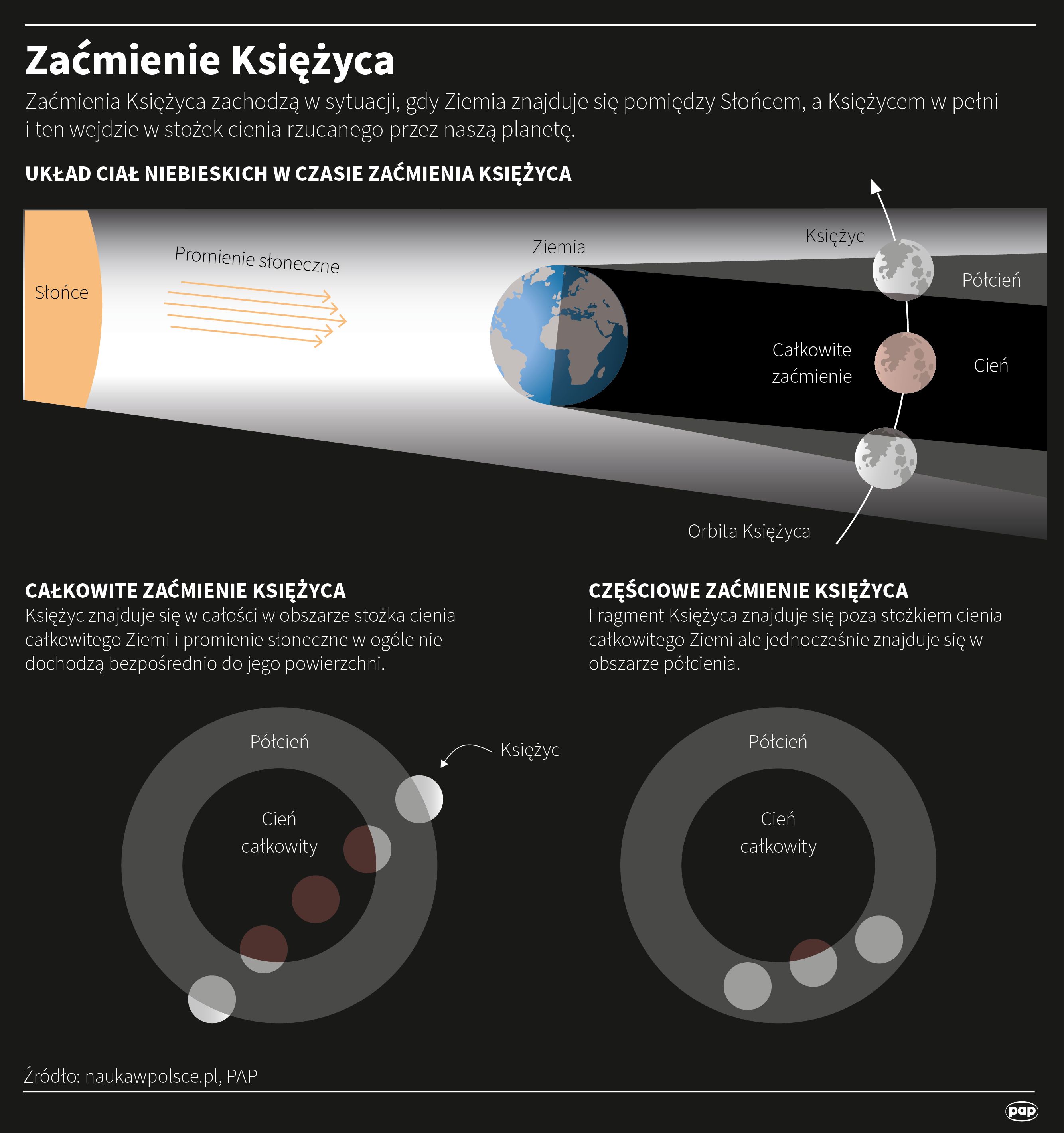On Sunday we will see a total lunar eclipse

On September 7th, an exciting astronomical phenomenon awaits us. The Moon will pass into Earth's shadow, resulting in a total eclipse of our planet's natural satellite. The phenomenon will be visible from Poland.
There will be a chance to see the Moon redden during its total eclipse. The maximum phase of the total eclipse will be 1.36, meaning the Moon will be quite deep in Earth's shadow, meaning there's a chance for intense red colors.

In addition, it will be near the perigee of its orbit (the point of its orbit closest to Earth), meaning its disk will be larger than average. This period during the full moon is called a supermoon or a supermoon. Therefore, we will be able to see a "superblood moon."
Most people are familiar with the various phases of the Moon, from new moon (the Moon's disk is completely unilluminated for an observer on Earth) to full moon (the Moon's disk is completely illuminated). During the full moon phase, the Moon is on the opposite side of the Earth from the Sun. We then see the entire Moon illuminated by our daytime star. Lunar eclipses occur when the Moon is full. However, not every full moon will have an eclipse. This is because the Moon's orbit around the Earth is tilted by several degrees relative to the Earth's orbit around the Sun, so it doesn't always enter Earth's shadow during a full moon.
There are several types of lunar eclipses: total, partial, and so-called penumbral eclipses. During a total eclipse, we will see—sooner and later—all of these stages. When the Moon is entirely within the Earth's total shadow, the Sun's rays do not reach its surface directly at all, and we see a total eclipse. If part of the Moon is within the Earth's total shadow, and the rest is within the Earth's penumbra, we are dealing with a partial eclipse. However, if the Moon is within the Earth's penumbra, we are talking about a penumbral eclipse. In the penumbra, the Earth blocks only part of the Moon's sunlight, while in the total shadow, it blocks the entire solar disk.
The September eclipse will take place as follows (times are given in Polish official time): beginning of penumbral eclipse at 5:28 p.m.; beginning of partial eclipse at 6:27 p.m.; beginning of total eclipse at 7:31 p.m.; maximum of the eclipse at 8:13 p.m.; end of total eclipse at 8:53 p.m.; end of partial eclipse at 9:56 p.m.; end of penumbral eclipse at 10:56 p.m.
The moon will rise in Poland around 7 p.m. or slightly later, depending on the region. That is, approximately half an hour before the total phase begins. Therefore, when it emerges from the horizon, despite the full moon, only part of its disk will be illuminated (it will then be undergoing a partial eclipse).
A characteristic feature of total lunar eclipses is the appearance of a red color on the Moon. This is because, although Earth blocks direct sunlight, it still passes through Earth's atmosphere. This atmosphere, in turn, has the property of scattering light with shorter wavelengths (blue) more readily than longer wavelengths (red). Therefore, longer wavelengths reach the Moon and are reflected from its surface, which we see as a reddish color. The intensity and hue of this color depend on the state of Earth's atmosphere.
The eclipse will be visible from Poland when the Moon is low on the horizon. This has its advantages and disadvantages.
The positive aspects certainly include the landscape aspect. The Moon will be low, which provides an opportunity to photograph it with elements of the Earth's landscape, i.e., landscape astrophotography. Additionally, when the Moon is low on the horizon, it sometimes appears larger. In reality, it doesn't change size; it's merely an illusion, but it certainly makes the view more spectacular.
Additionally, when it's really low on the horizon, it can appear slightly orange or red, similar to the Sun at sunrise or sunset. This is a different source of reddening than the one mentioned during totality, although the physical mechanism is similar. Here, we're dealing with scattering by the thick layer of atmosphere when viewing an object low on the horizon; blue is scattered more strongly, and we end up with red.
The thickness of the atmosphere at this viewing angle also causes a negative effect, known as atmospheric extinction, which is the stronger scattering and absorption of light by the atmosphere. This always makes astronomical objects slightly fainter and less distinct when they are very low. Furthermore, we may see distant clouds on the horizon.
You can watch the lunar eclipse simply by going outside to a location unobstructed by streetlights and unobstructed by buildings or trees. You can also use binoculars or a telescope. Various institutions (planetaria, science centers) and astronomy associations or clubs will organize demonstrations of the phenomenon, some of which will be accompanied by lectures. There will also be online broadcasts on astronomy channels.
Detailed information about lunar eclipses and other astronomical phenomena throughout the year can be found in the "Astronomical Almanac" published by the Polish Astronomical Society. The publication is available free of charge at . The timing of each stage of the eclipse is based on this almanac. (PAP)
cha/ bar/
naukawpolsce.pl





